#deadbeef
Explore tagged Tumblr posts
Text
DeadBeef на Linux Mint
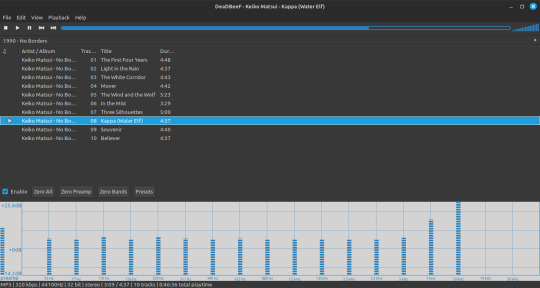
$ sudo add-apt-repository ppa:starws-box/deadbeef-player $ sudo apt update
Next, install DeadBeef:
$ sudo apt install deadbeef
#русский текст#русские посты#русский пост#русский tumblr#русский блог#русский тамблер#линукс#аудиофилия#deadbeef#плеер
4 notes
·
View notes
Text
High-cost battles? Losers just hit their pain threshold, not brains. Models hacked by nature’s desert-cult logic. 🌵 Study shows theorists got schooled in the war of attrition. #Deadbeef
https://besjournals.onlinelibrary.wiley.com/doi/10.1111/1365-2656.70058
0 notes
Text
i lied theres two windows programs i miss so much and its foobar2000 and 7Zip
for 7-Zip, "Ark" is a really good alternative i have no issues with other than it uses a shit ton of dependencies from KDE and i dont use KDE plasma so i just have like an app woth 30 packages for no reason that nothing else uses at all.
for foobar2000. its joever. most people just run it in WINE but it doesn't work too well. ive tried deadbeef, strawberry, audacious, literally none are as good. i miss u so much babygirl
11 notes
·
View notes
Text
I wrote a bakudeku fic.
um its just little kids loving each other and then forgetting about it causing their teenage selves to rebuild what never should have been lost.
#my hero academia#mha#bakudeku#bakugou katsuki#midoriya izuku#i mostly post about dan and phil but the mha hyperfixation resurged and this was born#mha fanfiction#bakudeku fanfic
11 notes
·
View notes
Text
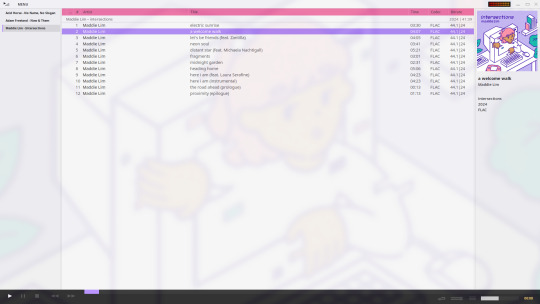
Trying out Tauon Music Box, I think this just might be my new favourite music player. It does look really pretty and clean, but I generally have my music player minimised so looks aren't all that important to me.
Aside from being open source, has support for Wayland, PipeWire, ListenBrainz/LastFM, etc. what is even more important to me is being fairly customisable, and it's SNAPPY, it opens nearly instantly.
It also uses SDL, in all likelihood it uses that for hardware acceleration, but more amusingly through SDL it supports gamepad input. So if you wanted to control your music player with your gamepad, there it is. I haven't tried that myself but it's an option.
Now, playlist management. Tauon actually made me reconsider how I manage my playlists.
Before Tauon, I used Foobar2000 through Wine (lmao right), before moving onto DeaDBeeF, and then Audacious.
In these programs I just made one playlist per album, so as my collection grew that kinda became a lot of playlists. Audacious for example, would take several seconds to boot because I was torturing it with my silly playlist management.
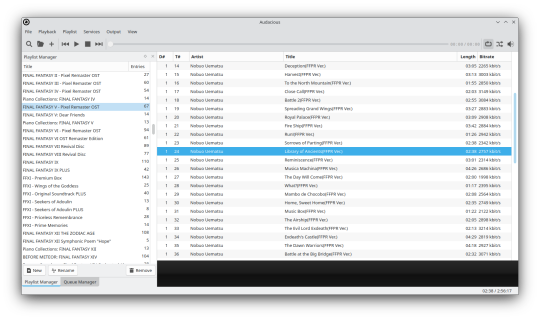
But that was my workflow, I liked it, it was tidy to me, and it let me find my favourite albums fast. If I lumped every album in these programs, there were generally no options to separate them. Maybe there was in one of these, but at that point I was just stubborn.
Tauon's interface changed that for me, because when adding multiple albums to a playlist it intuitively names the playlist after the album artist, then separates them nicely by album. Additionally it also shows their release years and length. Multiple discs are handled gracefully too.
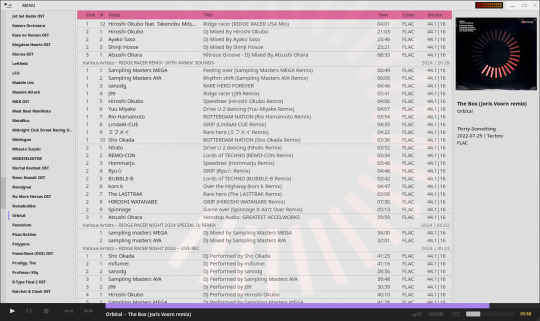
I still love F2K, DeaDBeeF, and Audacious mind you, and I see no reason as to why they can't all coexist with Tauon, they just serve different purposes and people I think.
The only downside to Tauon I personally found was no support for SID or SSF playback, but c'mon.. Not really world-ending.
That being said, Tauon does make a damn bold claim:

And I think it just might be.
2 notes
·
View notes
Text
1* 2.6.2. 3 3B2 5.0i 5.1 5.53 7 15kg 17 20 22nd 26 50BMG 51 69 97 312 411 414 707 737 747 757 767 777 868 888 1071 1080H 1911 1984 1997 2600 3848 8182 $ & ^ ^? a ABC ACC Active ADIU advise advisors afsatcom AFSPC AHPCRC AIEWS AIMSX Aladdin Alica Alouette AMEMB Amherst AMW anarchy ANC Anonymous AOL ARC Archives Area51 argus Armani ARPA Artichoke ASIO ASIS ASLET assasinate Asset AT AT&T Atlas Audiotel Austin AVN b b9 B.D.M. Badger bank basement BATF BBE BECCA Becker beef Bess bet Beyond BfV BITNET black-bag Black-Ops Blackbird Blacklisted Blackmednet Blacknet Bletchley Blowfish Blowpipe BMDO BND Bob BOP BOSS botux BRLO Broadside Bubba bullion BVD BZ c Cable CANSLO Cap-Stun Capricorn card Case CATO CBM CBNRC CBOT CCC CCS CDA CDC CdC cdi Cell CESID CFC chaining chameleon Chan Chelsea Chicago Chobetsu chosen CIA CID CIDA CIM CIO CIS CISE Clandestine Class clone cocaine COCOT Coderpunks codes Cohiba Colonel Comirex Competitor Compsec Computer Connections Consul Consulting CONUS Cornflower Corporate Corporation COS COSMOS Counter counterintelligence Counterterrorism Covert Cowboy CQB CRA credit cryptanalysis crypto-anarchy CSE csystems CTP CTU CUD cybercash Cypherpunks d D-11 Daisy Data data data-haven DATTA DCJFTF Dead DEADBEEF debugging DefCon Defcon Defense Defensive Delta DERA DES DEVGRP DF DIA Dictionary Digicash disruption
DITSA DJC DOE Dolch domestic Domination DRA DREC DREO DSD DSS Duress DynCorp E911 e-cash E.O.D. E.T. EADA eavesdropping Echelon EDI EG&G Egret Electronic ELF Elvis Embassy Encryption encryption enigma EO EOD ESN Espionage espionage ETA eternity EUB Evaluation Event executive Exon explicit Face fangs Fax FBI FBIS FCIC FDM Fetish FINCEN finks Firewalls FIS fish fissionable FKS FLAME Flame Flashbangs FLETC Flintlock FLiR Flu FMS Force force Fort Forte fraud freedom Freeh froglegs FSB Ft. FX FXR Gamma Gap garbage Gates Gatt GCHQ GEO GEODSS GEOS Geraldton GGL GIGN Gist Global Glock GOE Goodwin Gorelick gorilla Gorizont government GPMG Gray grom Grove GRU GSA GSG-9 GSS gun Guppy H&K H.N.P. Hackers HAHO Halcon Halibut HALO Harvard hate havens HIC High Hillal HoHoCon Hollyhock Hope House HPCC HRT HTCIA humint Hutsul IACIS IB ICE ID IDEA IDF IDP illuminati imagery IMF Indigo industrial Information INFOSEC InfoSec Infowar Infrastructure Ingram INR INS Intelligence intelligence interception Internet Intiso Investigation Ionosphere IRIDF Iris IRS IS ISA ISACA ISI ISN ISS IW jack JANET Jasmine JAVA JICC jihad JITEM Juile Juiliett Keyhole keywords Kh-11 Kilderkin Kilo Kiwi KLM l0ck LABLINK Lacrosse Lebed LEETAC Leitrim Lexis-Nexis LF LLC loch lock Locks Loin Love LRTS LUK Lynch M5 M72750 M-14 M.P.R.I. Mac-10 Mace Macintosh Magazine mailbomb man Mantis market Masuda Mavricks Mayfly MCI MD2 MD4 MD5 MDA Meade Medco mega Menwith Merlin Meta-hackers MF MI5 MI6 MI-17 Middleman Military Minox MIT MITM MOD MOIS mol Mole Morwenstow Mossberg MP5k MP5K-SD MSCJ MSEE MSNBC MSW MYK NACSI NATIA National NATOA NAVWAN NAVWCWPNS NB NCCS NCSA Nerd News niche NIJ Nike NIMA ninja nitrate nkvd NOCS noise NORAD NRC NRL NRO NSA NSCT NSG NSP NSWC NTIS NTT Nuclear nuclear NVD OAU Offensive Oratory Ortega orthodox Oscor OSS OTP package Panama Park passwd Passwords Patel PBX PCS Peering PEM penrep Perl-RSA PFS PGP Phon-e phones PI picking
Pine pink Pixar PLA Planet-1 Platform Playboy plutonium POCSAG Police Porno Pornstars Posse PPP PPS president press-release Pretoria Priavacy primacord PRIME Propaganda Protection PSAC Pseudonyms Psyops PTT quiche r00t racal RAID rail Rand Rapid RCMP Reaction rebels Recce Red redheads Reflection remailers ReMOB Reno replay Retinal RFI rhost rhosts RIT RL rogue Rolm Ronco Roswell RSA RSP RUOP RX-7 S.A.I.C. S.E.T. S/Key SABC SACLANT SADF SADMS Salsa SAP SAR Sardine sardine SAS SASP SASR Satellite SBI SBIRS SBS SCIF screws Scully SDI SEAL Sears Secert secret Secure secure Security SEL SEMTEX SERT server Service SETA Sex SGC SGDN SGI SHA SHAPE Shayet-13 Shell shell SHF SIG SIGDASYS SIGDEV sigvoice siliconpimp SIN SIRC SISDE SISMI Skytel SL-1 SLI SLIP smuggle sneakers sniper snuffle SONANGOL SORO Soros SORT Speakeasy speedbump Spetznaz Sphinx spies Spoke Sponge spook Spyderco squib SRI ssa SSCI SSL stakeout Standford STARLAN Stego STEP Stephanie Steve Submarine subversives Sugar SUKLO SUN Sundevil supercomputer Surveillance SURVIAC SUSLO SVR SWAT sweep sweeping SWS Talent TDM. TDR TDYC Team Telex TELINT Templeton TEMPSET Terrorism Texas TEXTA. THAAD the Ti TIE Tie-fighter Time toad Tools top TOS Tower transfer TRD Trump TRW TSCI TSCM TUSA TWA UDT UHF UKUSA unclassified UNCPCJ Undercover Underground Unix unix UOP USACIL USAFA USCG USCODE USCOI USDOJ USP USSS UT/RUS utopia UTU UXO Uzi V veggie Verisign VHF Video Vinnell VIP Virii virtual virus VLSI VNET W3 Wackendude Wackenhutt Waihopai WANK Warfare Weekly White white Whitewater William WINGS wire Wireless words World WORM X XS4ALL Yakima Yobie York Yukon Zen zip zone ~
4 notes
·
View notes
Text
DeaDBeeF: The Ultimate Music Player
https://deadbeef.sourceforge.io/
1 note
·
View note
Text
Wondering why node.js is gaining popularity? When to use node.js? This page has all the details you need about Node.js framework and related best practices in the community. Node.js unravels concurrency by supplanting the Java platform’s standard, multithreaded methodology with single-threaded, event driven I/O. In this article, we discuss Node.js and clarify why its event driven concurrency has started so much intrigue, even among hardcore Java developers. We then demonstrate you some Node.js best practices to influence Node’s Express framework, Mongolian DeadBeef, and MongoDB to assemble a concurrent, adaptable, and persistent web application. Some Historical Background In last couple of years, JavaScript has risen as a “dark knight,” type of legend for web application development. This fact surprises many web app developers, who used to dismiss JavaScript as a "toy language". While there are more famous languages, JavaScript’s special status as the standard, browser-neutral scripting language has helped it stay in the mainstream. For client-side web app development, it is arguably the most used language across the globe. JavaScript additionally has a spot in server-side scripting, and that aspect is developing. While there have been endeavors at server-side JavaScript previously, none has apparently caught as much energy as Node.js, or Node. What Is Node.js? Node.js is an open source, cross-platform runtime environment for server-side and networking applications. Node.js applications are developed in JavaScript, and those apps can run inside of the Node.js runtime on OS X, Microsoft Windows, Linux, FreeBSD, NonStop and IBM. Purpose Intended to help developers in building adaptable system programs, Node is a server-side programming environment that has basically reevaluated JavaScript for an entire new era of developers. For some Java developers, Node’s greatest advantage is its crisp way to deal with programming concurrency. While the Java platform keeps on developing in its way to deal with concurrency (with greatly anticipated improvements in Java 7 and Java 8), the important fact is that it fulfills a special need, and it does so in such a tremendous way that a lot of JavaScript developers is embracing it. Like client-side scripting with JavaScript, server-side scripting in the Node environment is so great in light of the fact that it just works, and it’s working in a region where numerous Java developers are as of now tested. In this article, we will begin with a structural outline of what makes Node extraordinary, and after that we’ll demonstrate industry standards to swiftly build an adaptable web application that influences MongoDB for information industriousness. As a reader, you can observe that, how fun Node is, and how rapidly one can use it to build a working web application. Why Node.js is So Popular? There are many reasons all tech giants are loving node.js. More and more applications are being developed using Node.js and its getting adopted by industry really fast. Here are some obviously visible reasons whey Node.js is so popular. Easy To Learn Node.js is a easy to learn environment. Its a thin stack primarily based on JavaScript and developers are mainly focused on learning JavaScript programming. Many existing JavaScript developers are easily able to learn it on their own. At the same time there is plenty of good node.js books available for beginners at node. Those who do not know JavaScript can also easily learn from JavaScript tutorials freely available on web. Beginner at JavaScript can refer good javascript books. Node.js Has Cross Platform Support Node.js is available on all popular operating systems including Linux, Windows and Mac OSX. An easy installer is available for all environments. Node.js Scalability and High Performance The main reason for quick adoption of Node.js is its performance on production systems. Many high traffic production systems are deployed and being served with Node.
js. Companies like Paypal and Walmart have reported their Node.js apps are performing really well in high volume traffic and easily scaled up. Node’s Event Driven Concurrency Node is a versatile, event driven I/O environment based on top of Google’s V8 JavaScript engine. Google V8 really incorporates JavaScript into local machine code before execution, bringing about amazingly quick runtime execution — something not commonly associated with JavaScript. Thusly, Node empowers you to quickly build network applications that are extremely quick and very concurrent. Event driven I/O may sound remote to a Java developer’s ears, yet it isn’t too new. Instead of the multithreaded programming model we’re used to on the Java platform, Node’s way to deal with concurrency is single-threaded, with the extra kick of an event loop. This Node build empowers non-blocking or asynchronous I/O. In Node, invocations that commonly would block, for example, waiting for database query results, don’t. Instead of hold up for costly I/O exercises to finish, a Node application issues a callback. At the point when an asset is given back, the joined callback is summoned non-concurrently. Concurrency just works in Node programs. If I needed to run the past scenario on the Java platform, I would have my decision of complex and prolonged methodologies — from conventional threads to fresher libraries in Java NIO and even the enhanced and redesigned java.util.concurrent package. While Java concurrency is capable, it can be hard to comprehend — which translates to code. Node’s callback system, by examination, is incorporated with the language; you don’t need special constructs like synchronized to make it work. Node’s concurrency model is amazingly simple, and that makes it accessible to a wider audience of developers Better Talent Availability and Retention Though you can find thousands of Java developers, however the availability of Node.js developers is not poor either. The Node.js developers are plenty on best freelance websites. Better Productivity Since Node.js is developed using JavaScript on both server and client side. The development is much faster and consistent. One JavaScript developer can understand and develop the application end to end without worrying about interaction complexity between layers of client and server side. Java based application may still require a JavaScript developer to device a rich user interface and a in depth communication may be required between JavaScript programmers and java developers. Active Community Node.js community is very active and quick help is always available on popular forums and discussion boards. Stackoverflow has 80K+ questions that are asked by people and very few are unanswered. Plenty Of Useful Tools For Developers Since Node.js is mainly JavaScript its easy to find tools for it. Many IDEs and developer tools are already available for JavaScript that can be used for Node.js. JavaScript is understood by the browser therefore there are many cloud based JavaScript IDE available for it to develop and debug Node.js online. Easy Node.js Hosting Though you can go for a dedicated hosting servers options and easily setup your own Node.js infrastructure. However there are many easy to setup hosting providers available for Node.js environment. These providers already have a basic setup for Node.js applications and helps you quickly get to your business. Here is a list of hosting providers that support Node.js Why Pick Node.js? The Java platform’s approach to concurrency served to set up its leading part in big enterprise development, and that isn’t likely to change. Frameworks like Netty (and Gretty) and center libraries like NIO, and also java.util.concurrent, have settled on the JVM a top decision for concurrency. What’s unique about Node is that it is a current development environment particularly intended to determine the difficulties of simultaneous programming. Node’s event driven programming
ideal model implies that you needn’t bother with extra libraries to make concurrency work, and that is uplifting news for developers peering toward multicore equipment. Where Can We Use Node.js? There are many web application scenario where node.js works much better than a traditional server side programming language like java or PHP. The main advantage of Node.js is use of real time two way connection between client and server. This make node.js a popular choice for rich client applications that has many small components that can be interacting with server in parallel. If you want to create a dashboard application with multiple types of data formats and components on a page. Node.js may be a good choice. Some practical applications where node.js may go really well are listed below. Displaying a Stock market dashboard Website monitoring dashboard for dev ops Live network stats on a web page Production system monitoring dashboard Chat application Applications that run on JSON based NOSQL databases. Applications that require interaction with Mobile device and native apps. Applications that require interaction with Internet of things (IOT) based devices Where Should We NOT Use Node.js? Just like any other option, Node.js is not a one size fits all solution for all your problems. Below are types of system where node.js may not be a good choice. Applications that involve heavy computations and require more CPU processing Applications that interact with relational database like Oracle, MySQL or Postgress Conclusion Node’s JavaScript linguistic structure likewise spares you keystrokes, for sure. With only a little code, you can manufacture a quick, versatile web application that is equipped for taking care of bunch simultaneous associations. You can do that on the Java platform; however you’ll require more lines of code and a group of extra libraries and develops. What’s more, in case you’re agonized over exploring another programming environment, don’t be: Node is anything but difficult to get on the off chance that you know some JavaScript, which I bet that you do. I am an app developer, working in a smartphone applications developer company called Cygnis Media. My main interest is in mobile phone app development, but I also love to read & write about other technologies too. I like to share my knowledge, expertise, and experiences with different tech-communities on the web via social media platforms and tech blogs.
0 notes
Note
hi! i saw your post about downloading music and such. would be willing to talk more music players and organizers/libraries? specifically syncing between devices, such as from computer to phone?
hey there, sorry for taking so long to respond! i've been a little bit busy
for desktop
for desktop players, i mentioned dopamine in the last post. i've been using deadbeef, which is decently customizable and has last.fm support. VLC always exists
syncing
this section got kind of long, sorry! i've separated it into chunks to hopefully be more readable
there are some options depending on what you want. you could carry an old-fashioned USB around, but that's most likely not really convenient for most people.
for a lot of people, the best play is to keep the music locally on your computer (or on a hard drive) and sync it over to your phone, since computers usually have more storage
if you use android, syncthing does p2p synchronization (there are apps for ios too, but i'm not sure how good it is). i can't speak much to this, since i've never used syncthing myself
syncing over cloud services is an option. if whatever you use has a built-in music player (eg. you can play audio files on the google drive site and app), you could do that, though i wouldn't really recommend it.
there are very likely music apps that allow you to just pull music from a cloud storage account like google drive or onedrive, but i don't know any specific ones off the top of my head.
instead of using proprietary cloud services, it may be worth looking into nextcloud. there are some free-to-use instances, but you usually only get 2GB of storage, which might not be viable depending on how much music you want to sync. there's a music player "app" (extension). i'm not exactly sure if there's a music player on the nextcloud mobile app?
if you're using nextcloud or another cloud service that supports webDAV, you've got a lot more options available for music players. many music player apps support pulling from a webDAV server. just from a quick google search, here's one for ios (supports nextcloud itself too), and here's one for android. if you're on android, you'll probably find a lot more good options (take a look on github?)
i don't listen to much music from my personal collection at the moment since i have apple music (i wanna set up a server in the future), but what i did is add a synced folder in readdle's documents app, which pulls from a folder on a nextcloud instance. all of penelope scott's songs automatically download so i can listen offline, and the rest i can stream from the server.
speaking of apple music, if you're in the apple ecosystem, i'm pretty sure you can use icloud to sync your local music to your phone and listen there. here's a guide
if you're techy enough and have the time/effort, it may be worth getting a VPS, an old computer, or a raspberry pi and self-hosting a media streaming server. i've heard good things about navidrome (music-only) and jellyfin (video and audio). these have web players and pretty good mobile app integrations— you can find some by doing a quick search. for navidrome apps, look for "navidrome" or subsonic"
plex also seems pretty popular, but it's proprietary so i'd prefer looking into FOSS options
you could also set up a nextcloud instance if you want, but i don't really see why you'd prefer that if you have the option for a dedicated media server
i hope this covers most of what you wanted to know! this is something i'm still wrangling with myself, so there's a lot i wanted to talk about. let me know if you have any more questions [:
1 note
·
View note
Text
omg i think i just found like. basically lost media. nobodys talking about it but theres videos and screenshots of it. fucking. Space Deadbeef. for iphone 1. love that game. still have it. but i need more people who know about it. so fucking FUN i want a pc remake or somethiiiiiiiiiiiiiing with more levels you can beat that game in minutes but its so fun and replayable and the level 1-00 soundtrack is fucking amazing hold on let me record it
o'course i cant record it smoothly cuz you have to shoot ships to not die. and they explode loud. GO LOOK UP A VIDEO theres a recording of the developer playing it. but they start on level 3-00 and thus you cant hear the music there. ive made a request for a gamerip on khinsider but idk if itll be done.
ALSO uh FASTLANE. racing game. real hard. songs i love that u can play on the menu.
oh also... 'Madness'. tower defense. defend sheep from aliens. love the menu theme.
and last but not least, Tetris (EA), most intuitive controls for any tetris game ive played, with the best Korobeinki rendition ive heard. there IS a "modern" track you can play instead but it just plays silence for me.
kthxbai
1 note
·
View note
Text
Biggest frustration with Linux so far is that I can't find a music player I like.
Strawberry - closest match so far, but I like to browse my music library by scrolling through an album cover grid, and you can only display the cover grid in a separate window, not as part of the main interface. Yes, this is a dealbreaker.
Deadbeef - doesn't have a library manager at all. WTF. Makes about as much sense as an OS without a file manager
gmusicbrowser - looks promising, but I can't figure out how to install the dependencies to run it.
I really miss foobar2000.
1 note
·
View note
Text
Programmers do this a lot because we often look at memory values as hex. But we use 4 or 8 letters because that’s a typical size of memory value. Some well known ones are
DEADBEEF — various debugging tools will scribble this into unused or freed memory, so if you see it you know something's been reading memory it shouldn’t.
CAFEBABE — stored in the first 4 bytes of every Java code file to identify what it is
I love summons with words for codes. FACADE. BAD455.
I wonder how many words there are in hex code.
I decided to google after typing this, and found a handful
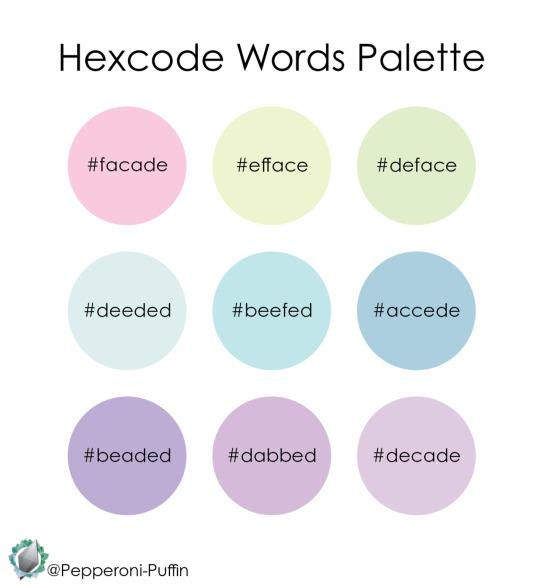
2K notes
·
View notes
Text
second chapter of my bakudeku fic
katsukis kind of stupid but we love him anyways
15 notes
·
View notes
Audio
dEaDbEeF by Paris death Hilton 🆕 added to our Spotify playlist 🎧 New Sounds of Japan #jpop #jrock #jmusic ⏩ https://open.spotify.com/playlist/6ITw0LEjdZne0uqE0t13g6?si=FV7Z4JUVS2ChbDH-fNeKjA
0 notes
Text
oooh! my guess is we're going to get mostima alter because key unlock and probably lemuen as the non-limited for the anniversary then
I'm far from an expert on the subject and I only associate \xde aka deadbeef with exploits but apparently it is also used in debugging so eh. to me it reads like the OS detects "danger" > analyzing leads to unintialized memory causing fatal exception (and indicating that there already was something wrong with the system before the first line?) > system hits another memory-related snag > buffer overflow > kernel security terminates process over stack smashing, indicating potential corrupted memory > OS failures continue and get worse (CRITICAL_PROCESS_DIED) > UNLOCK line > new processing unit unlocked > things get even worse and memory corruption is confirmed > more crashes (logic_error) > system exhausts resources entirely (OutOfMemory, bad_alloc) > total system failure (LATERANO OUTBREAK). To me it reads like UNLOCK was a command or payload to gain higher access privileges exploiting earlier vulnerabilities in the code, but it could also be that the system itself is unlocking the new processing unit to analyze the "danger", to no avail (computational power threshold exceeded)? anyway I'm a shit coder but this was a fun brain scratcher


well. we're going back to vatican

117 notes
·
View notes
